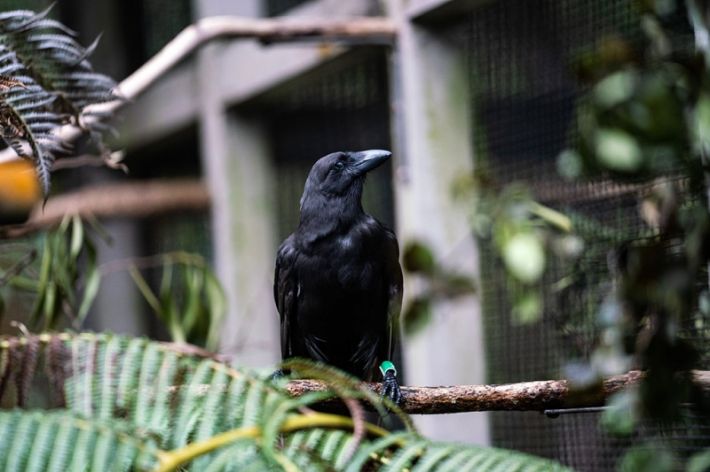Light streams down through a small window onto the face of Cody Pacheco KSH’17, a Kāpili ‘Oihana Internship Program (KOIP) participant working at the Keauhou Bird Conservation Center situated within an expansive forest on Hawai‘i Island.
He peers into a large aviary that houses a pair of ʻalalā, the endangered Hawaiian crows that remain on the brink of extinction. Pacheco adjusts his video camera, and prepares to take notes. He is hiding from the birds, in near darkness, waiting silently with other interns and scientists for the test to begin. A lone black bird sits on a perch as the recorded call of an ‘io (Hawaiian hawk) is fed into the aviary. The bird perks up and another ʻalalā swoops down to join its companion.
They look at each other intently. An ‘io suddenly appears just outside the aviary and the ‘alalā let out screeching calls to alert one another of impending danger. The birds are unaware that this particular ʻio happens to be a puppet used be researchers to mimic the natural predator and test how the ʻalalā react to the aerial hunters.
Pacheco is one of three Kāpili ‘Oihana interns that worked at the conservation center last summer, and their research contributed to the native birds’ increased chance of eventually being successful in the wild one day.
“I've always wanted to work at the Keauhou Bird Conservation Center but I never really found my way into it or how to get here, so Kāpili ‘Oihana was the perfect opportunity for me,” said Pacheco, who is currently studying at the University of Hawaiʻi at Hilo. “There are not a lot of opportunities like that in the conservation world in Hawai‘i just because we don't have many animal species to work with in general, so the opportunity to do hands-on work with this native bird population is something entirely new for me.”
Kamehameha Schools’ KOIP team recently completed its 11th year of providing Native Hawaiian college students with the opportunity to apply academic experience in a real-world setting by working with community organizations to increase students’ hiring potential upon graduation. The program aligns with KS’ dedication to foster enduring relationships with community partners that are dedicated to developing future Native Hawaiian leaders through career opportunities, including internships, job shadows, career presentations, mentorships and employment possibilities. The 2019 edition of KOIP included 140 interns – a 26% increase from the cohort of 111 in 2018 – working at 76 host organizations over the summer.
At the KOIP Hō‘ike last fall, interns, businesses and KS staff demonstrated the importance of and resulting success from cultivating and maintaining relationships. Through KOIP, interns build their professional networks, develop transferable skills, and create solutions to real-world challenges. KOIP also exposes students to cultural experiences that contribute to the development of future leaders who recognize and embody the foundational values of kūpuna in their communities and workplace.
“Education is the pursuit of knowledge, the answer is clear: ma ka hana ka ʻike, by doing things we acquire knowledge,” said Kāʻeo Duarte, KS vice president of community engagement and resources, while addressing attendees at the KOIP Hōʻike. “I see our Lāhui across every industry segment, from ʻāina to technology, to accounting to media, to health and education. That is what’s going to build our Lāhui! I’m excited, and I look forward to one of you taking over my job one day.”
Brissa Christophersen KSM’15, a senior at Humboldt State University, credits KOIP for “helping me find what I want to do after college, specifically in conservation, and the experience really reconfirmed my passion for wildlife conservation and working with birds in the future.”
Christophersen appreciated being able to work in the field with palila (endangered Hawaiian honeycreepers) and learning how to use radio telemetry to track them, as well as working with the ʻalalā release and monitoring team.
“This internship gave me a fresh perspective, and an opportunity to work with different partners and different people that can potentially help me get a job after college,” Christophersen said. “I wanted to work with the ʻalalā to feel like I made a difference in helping them come back from extinction. I really enjoy working with birds, and being from Hawai‘i, there is a need to continue the underrated conservation work being done.”
As KOIP continues to grow, so do the program participants who make great strides toward forging career pathways during their work over the summer.
Jesse Mikasobe-Kealiʻinohomoku is a recent KOIP intern who worked with Mālama Learning Center to study food system sustainability through MA‘O Organic Farms and the University of Hawai‘i-West O‘ahu. He is on pace to graduate in 2021, and the Wai‘anae High School product plans on using his research on rhizobacteria and his hands-on experience to bolster native ecology restoration efforts.
“Try your best, try your hardest, and if it makes you uncomfortable that’s the best part, because that’s where you grow,” said Mikasobe-Kealiʻinohomoku.
Pacheco added: “I feel like you should take full advantage of internships, regardless of if they're paid or not, because you never know where the experience is going to lead you.”

The Kāpili ‘Oihana interns focused in part on bolstering the waning population of ʻalalā, the endangered Hawaiian crows that remain on the brink of extinction.
TAGS
internships,
college and career success,
native hawaiian identity
CATEGORIES
Kaipuolono Article, Regions, West Hawai’i, Themes, Culture, Community, Newsroom, Community Education, Department News, LAD News
Print with photos
Print text only










